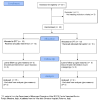Improving Upper Extremity Bradykinesia in Parkinson's Disease: A Randomized Clinical Trial on the Use of Gravity-Supporting Exoskeletons
- PMID: 35566669
- PMCID: PMC9104168
- DOI: 10.3390/jcm11092543
Improving Upper Extremity Bradykinesia in Parkinson's Disease: A Randomized Clinical Trial on the Use of Gravity-Supporting Exoskeletons
Abstract
Hand movements are particularly impaired in patients with Parkinson's Disease (PD), contributing to functional disability and difficulties in activities of daily living. Growing evidence has shown that robot-assisted therapy may be considered an effective and reliable method for the delivery of the highly repetitive training that is needed to trigger neuroplasticity, as intensive, repetitive and task-oriented training could be an ideal strategy to facilitate the relearning of motor function and to minimize motor deficit. The purpose of this study is to evaluate the improvement of hand function with semi-autonomous exercises using an upper extremity exoskeleton in patients with PD. A multicenter, parallel-group, randomized clinical trial was then carried out at the IRCCS Centro Neurolesi Bonino-Pulejo (Messina, Italy). Thirty subjects with a diagnosis of PD and a Hoehn-Yahr score between 2 and 3 were enrolled in the study. Patients were 1:1 randomized into either the experimental group (ERT), receiving 45 min training daily, 6 days weekly, for 8 weeks with Armeo®Spring (Volketswil, Switzerland) (a gravity-supporting device), or the control group (CPT), which was subjected to the same amount of conventional physical therapy. Motor abilities were assessed before and after the end of the training. The main outcomes measures were the Nine-hole peg test and the motor section of the UPDRS. All patients belonging to ERT and 9 out of 15 patients belonging to the CPT completed the trial. ERT showed a greater improvement in the primary outcome measure (nine-hole peg test) than CPT. Moreover, a statistically significant improvement was found in ERT concerning upper limb mobility, and disease burden as compared to CPT. Using an upper extremity exoskeleton (i.e., the Armeo®Spring) for semi-autonomous training in an inpatient setting is a new perspective to train patients with PD to improve their dexterity, executive function and, potentially, quality of life.
Keywords: Parkinson’s disease; gravity-supporting device; hand bradykinesia; neurodegenerative diseases; upper-limb rehabilitation.
Conflict of interest statement
The authors declare no conflict of interest.
Figures
Similar articles
-
The effect of task-oriented circuit training-based telerehabilitation on upper extremity motor functions in patients with Parkinson's disease: A randomized controlled trial.Parkinsonism Relat Disord. 2023 Apr;109:105334. doi: 10.1016/j.parkreldis.2023.105334. Epub 2023 Feb 28. Parkinsonism Relat Disord. 2023. PMID: 36917914 Clinical Trial.
-
Using an upper extremity exoskeleton for semi-autonomous exercise during inpatient neurological rehabilitation- a pilot study.J Neuroeng Rehabil. 2018 Aug 2;15(1):72. doi: 10.1186/s12984-018-0415-6. J Neuroeng Rehabil. 2018. PMID: 30068372 Free PMC article. Clinical Trial.
-
Who May Benefit From Armeo Power Treatment? A Neurophysiological Approach to Predict Neurorehabilitation Outcomes.PM R. 2016 Oct;8(10):971-978. doi: 10.1016/j.pmrj.2016.02.004. Epub 2016 Feb 20. PM R. 2016. PMID: 26902866
-
Effect of activity-based training versus strengthening exercises on upper extremity functions in Parkinson's patients; A randomized controlled, single blind, superiority trial.Clin Neurol Neurosurg. 2022 Jul;218:107261. doi: 10.1016/j.clineuro.2022.107261. Epub 2022 Apr 29. Clin Neurol Neurosurg. 2022. PMID: 35567829 Clinical Trial.
-
Effects of robot-assisted gait training on postural instability in Parkinson's disease: a systematic review.Eur J Phys Rehabil Med. 2021 Jun;57(3):472-477. doi: 10.23736/S1973-9087.21.06939-2. Epub 2021 Apr 7. Eur J Phys Rehabil Med. 2021. PMID: 33826278
Cited by
-
Cost analysis of technological vs. conventional upper limb rehabilitation for patients with neurological disorders: an Italian real-world data case study.Front Public Health. 2024 Oct 14;12:1445099. doi: 10.3389/fpubh.2024.1445099. eCollection 2024. Front Public Health. 2024. PMID: 39469213 Free PMC article.
-
The effects of exergames on upper extremity performance, trunk mobility, gait, balance, and cognition in Parkinson's disease: a randomized controlled study.Acta Neurol Belg. 2024 Jun;124(3):853-863. doi: 10.1007/s13760-023-02451-3. Epub 2024 Jan 5. Acta Neurol Belg. 2024. PMID: 38182919 Clinical Trial.
-
Type, Timing, Frequency, and Durability of Outcome of Physical Therapy for Parkinson Disease: A Systematic Review and Meta-Analysis.JAMA Netw Open. 2023 Jul 3;6(7):e2324860. doi: 10.1001/jamanetworkopen.2023.24860. JAMA Netw Open. 2023. PMID: 37477916 Free PMC article.
-
Areas of Research Focus and Trends in the Research on the Application of VR in Rehabilitation Medicine.Healthcare (Basel). 2023 Jul 18;11(14):2056. doi: 10.3390/healthcare11142056. Healthcare (Basel). 2023. PMID: 37510497 Free PMC article.
-
Effectiveness of robot-assisted training in adults with Parkinson's disease: a systematic review and meta-analysis.J Neurol. 2024 Dec 12;272(1):22. doi: 10.1007/s00415-024-12798-z. J Neurol. 2024. PMID: 39666104
References
LinkOut - more resources
Full Text Sources



